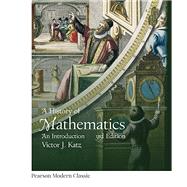This book is ideal for a junior or senior level course in the history of mathematics for mathematics majors intending to become teachers.
This title is part of the Pearson Modern Classics series. Pearson Modern Classics are acclaimed titles at a value price. Please visit www.pearsonhighered.com/math-classics-series for a complete list of titles.
A History of Mathematics, 3rd Edition, provides students with a solid background in the history of mathematics and focuses on the most important topics for today’s elementary, high school, and college curricula. Students will gain a deeper understanding of mathematical concepts in their historical context, and future teachers will find this book a valuable resource in developing lesson plans based on the history of each topic.








